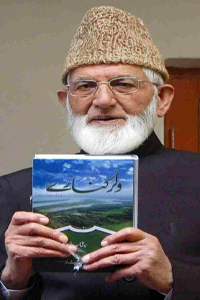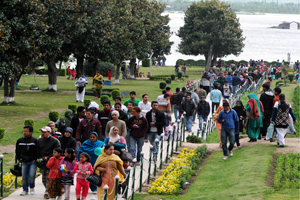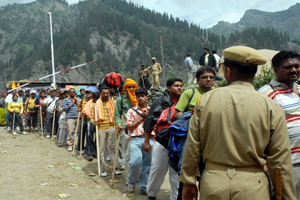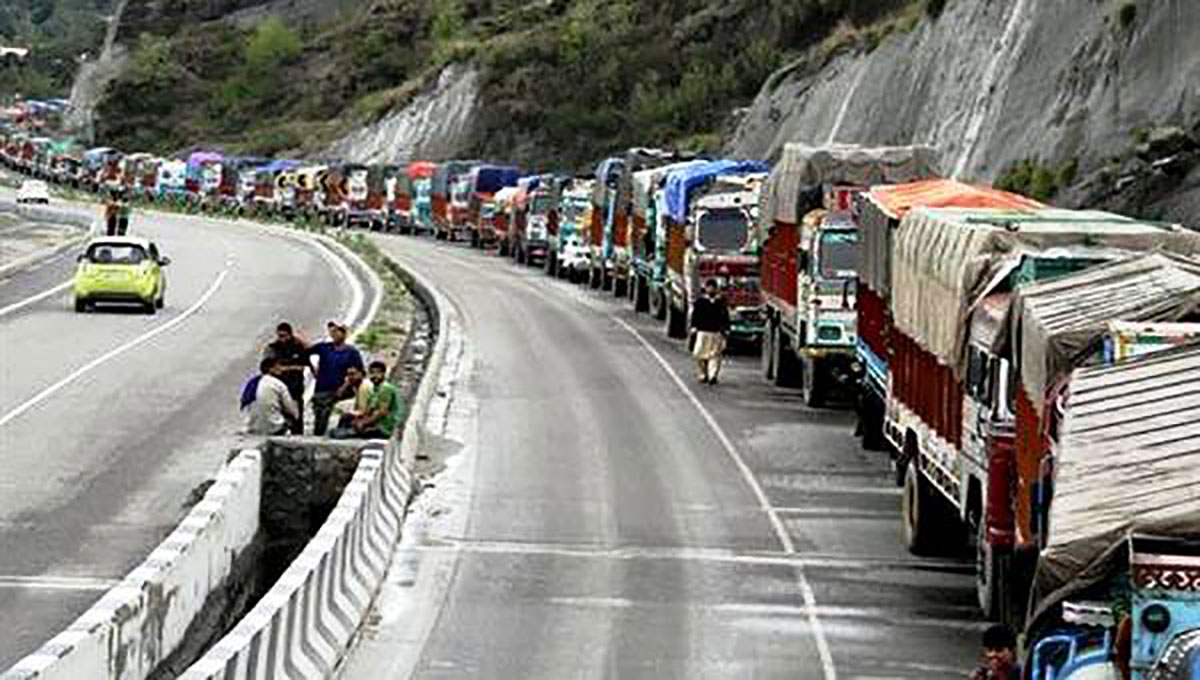Geelani’s Another VOLUME

The Hurriyat (G) Chairman, Syed Ali Shah Geeelani, was offered the prime ministership of Jammu and Kashmir by New Delhi during his detention in a Jammu jail in early 1990s. The revelation has been made by Geelani in the second volume of his autobiography Wular Kay Kinaray (On the banks of Wullar) which was written mostly during his constant house arrest since 2010.
The book, which was released at his Hyderpora residence, is a 686 page volume, which presents an account of the meetings between Geelani and Sheikh Muhammad Abdullah, the developments in the assembly during the yesteryears, and a detailed account of the lives of various political figures.
The book dealing apart from the history behind the formation and division of Muslim United Front and the causes of eruption of armed struggle in Kashmir, also mentions personalities like Late Sufi Muhammad Akbar and Late Abdul Gani Lone. He has also written about the April 4, 1979 incident and the people involved and the story behind the emergence of Syed Salahuddin from Muhammad Yousuf Shah.
Geelani has also written on the birth and evolution of Hurriyat Conference and its course in the years of struggle. The book is also said be carrying mention about “the atrocities of government gunmen, the people who gave up arms and participated in dialogue with India and also about the murderous attacks on him, Hazratbal and Charar-i-Sharief sieges.”
The forward for the book has been written by renowned scholar, Prof Khurseed, who heads Institute of Policy Studies in Islamabad, Pakistan. The book release function was attended by Syed Ali Shah Geelani, Mohammad Ashraf Sehrai, Gulam Nabi Sumji and parents of some youth who had lost lives in the ongoing struggle.
Millat Publication have already sold 400 copies of the book in New Delhi and 1600 copies has been kept for Kashmiri readers. The book is priced at Rs 450.
A New BOARD?
The summer tourist season is almost at its ebb and the official data suggests almost one third of tourists were Hindu pilgrims. The number of high spending tourist is dismissal and most of ‘tourists’ who have visited Kashmir till September have come to visit different holy places.
 Official data suggest that 9,519,170 pilgrims visited the state in 2012 till September. Of them, 8,309,395 are pilgrim tourists – 7,688,291 to Vaishno Devi and 621,104 to Amarnath. The balance 1,210,315 are luxury tourists. Of them, 1,070,027 have visited Kashmir and 140,288 visited Ladakh. Though most of the tourists are backpackers, the high-spending foreign component is only 54,460 of which 27,596 had come to Kashmir and 26,864 to Ladakh.
Official data suggest that 9,519,170 pilgrims visited the state in 2012 till September. Of them, 8,309,395 are pilgrim tourists – 7,688,291 to Vaishno Devi and 621,104 to Amarnath. The balance 1,210,315 are luxury tourists. Of them, 1,070,027 have visited Kashmir and 140,288 visited Ladakh. Though most of the tourists are backpackers, the high-spending foreign component is only 54,460 of which 27,596 had come to Kashmir and 26,864 to Ladakh.
On the other hand, Jammu and Kashmir is all set for the fourth autonomous board to manage the lesser known Machail Yatra that is conducted yearly in the Chenab Valley. Around 350,000 Hindu pilgrims trek a long distance to a high altitude temple set up not more than forty years back.
The Machail yatra is a comparatively newer Hindu pilgrimage in the state. It takes place in August and it starts from Bhadrwah’s Chenote temple. Pilgrims leave in long caravans and reach Kishtwar and then to remote Paddar. From there, they leave on foot to Paddar where the temple of Mata Chandi is located at 11,000 ft above sea level, not far away from the world famous sapphire mines. The entire yatra is a 175-kms trek and usually is open for around three weeks. 27 days. This pilgrimage owes its existence to a Bhaderwah cop, Thakur Kulbir Singh aka Mata, who started it during his posting in Paddar.
The Amarnath ISSUES
Setting aside concerns raised by many environmental advocacy groups regarding the widening of the road leading to Amarnath Shrine, the supreme court has directed the state government and the shrine board to begin with the widening of the track between Baltal and the cave shrine.
The court directed that the government and the Shri Amarnath Shrine Board (SASB) to immediately start implementing the safety measures recommended by the SC-appointed Special High Powered Committee (SHPC) for minimizing casualties among the pilgrims.
The committee had observed that the road to the cave shrine was too narrow and needs immediate widening. The committee in its report has identified several places where the widening work has been proposed to be taken up on war footing.
committee in its report has identified several places where the widening work has been proposed to be taken up on war footing.
The chief secretary and the board have been asked to prepare a blue-print for augmenting medical facilities all along the route. The court also asked both the parties to make provision for one-way passage to the shrine and to streamline the registration process of the pilgrims.
Special secretary (tourism and culture), AK Gupta in an affidavit filed in the court said the cabinet had agreed in principle with the recommendations of the SHPC for carrying out different activities by different agencies in accordance with the various statutory provisions, including those related to forests, wildlife sanctuaries and eco-sensitive zones.
A bench comprising Justices BS Chauhan and Swatanter Kumar passed the order after advocate general, MI Qadri informed the court that the state cabinet had accepted “in principle” the recommendations made by the SHPC.
The apex court had on July 20 this year constituted a high-level committee to recommend measures to prevent the growing number of casualties among Amarnath pilgrims saying it had become a permanent problem and a regular affair. The court had passed the order after taking suo motu note of media reports of pilgrims’ deaths allegedly due to lack of proper facilities and medical care for them. The state health ministry has rebuffed the claims of media reports of pilgrims’ deaths due to lack of proper facilities and medical care for them.
The supreme courts direction has come in wake of recommendations given by the Special High Powered Committee which was constituted by the Supreme Court to identify the reasons for high rate of deaths of devotees during the Amarnath pilgrimage this year and recommend suitable measures for avoiding similar situation in future.
The report had been submitted in the apex court by the state chief secretary, Madhav Lal, who had been appointed as the nodal officer for mobilizing the required action by the SHPC. The committee members had visited Shri Amarnath Shrine before culmination of the yatra to examine various matters related to the yatra arrangements.
The report says the government should provide all necessary funds for early implementation of the upgradation of Amarnath Yatra track before the commencement of the next yatra (2013) and ensure that all works are completed before the working season of 2013 is over.
The SHPC in its report, says, “In order to provide safe and smooth passage to the Yatris, particularly during the yatra period, when there is acute congestion on the tracks due to simultaneous movement of pedestrian yatris and those on ponies/palkies, the limited space is available and also keeping in view the environmental concerns, the upgradation works should be approved and taken up for implementation on fast track basis”.
“There is need for improvement of critical stretches of the existing track from Baltal to Holy cave, which can be implemented by the state PWD department with the assistance as may be required from other organizations such as Border Roads Organisation, which can comparatively mobilize the area quickly”, the report says.
The committee has also suggested measures to discourage on-spot registration of pilgrims at Jammu and base camps of Baltal and Nunwan.
Meanwhile, an interesting representation has been made by Piramal Systems & Technology to the committee, a copy of which also stands submitted before the state Governor and the chief secretary. The company had submitted a proposal to allow it to lay a six feet wide concrete anti-skid track from Panjtarni to the holy cave shrine without any financial support from the state government or the SASB. The company had also proposed to set up shelters at regular intervals for providing basic amenities such as health care, water, etc.
The report had also said that J&K police and Central Armed Police Forces should enlarge the provisions of the basic requirements like tents, bedding, toilet, etc. to their personnel deployed on yatra duty in order to provide them better working conditions.
While commenting on the health related issues of the pilgrims, the report says an expert medical committee comprising three medical specialists by union health ministry and one medical specialist nominated by the state government should review the format of the existing compulsory health certificate and suggest suitable modification therein, as required.
A Law AMENDED
Lately but the state government has accepted that Kashmir has the potential to set up new power projects or buying back projects already operating outside the state’s ownership in the state. For the purpose, the government has amended a vital law which will help in starting a new corpus to increase the revenue expenditure of the state.
Taj Mohiuddin, the minister for flood and irrigation says, “We have already collected Rs 728 crore from NHPC and another Rs 350 crore from the Power Development Corporation (PDC) and we have raised more bills worth Rs 723 crore for the last six months.” He also said that there will be a legal binding on the government not to use this money outside the power sector for buying back power projects or for creating new ones as the amount will help the power department to leverage the rupee better for equity in the upcoming projects.
The minister said the initiative has been taken to generate the non-plan requirements of the state government as the government has been facing crippling problems on the equity front. For the same problem, the last government had taken the initiative of selling the encroached state lands to the encroachers to create Rs 20,000 crore corpus but the change in chief minster during PDP Congress coalition and the emergence of Ghulam Nabi Azad as CM derailed the initiative who instead vested the ownership rights to the encroachers free.
The water usage charge is now emerging a new alternative to manage equity for new ventures. J&K is the only state in India that is levying water usage charges from water users especially the power producers (NHPC and PDC). NHPC has gone to the court against the charge saying it will upset the tariffs in the northern region and it is yet to be decided. Though CERC has permitted NHPC to offset the load by effecting changes in its tariffs, it is yet to have any impact in J&K.















